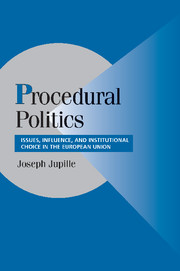Book contents
- Frontmatter
- Contents
- List of Figures
- List of Tables
- Preface and Acknowledgments
- List of Acronyms Used in the Text
- 1 INTRODUCTION: CHOICE, CONSTRAINT, AND EUROPEAN UNION INSTITUTIONS
- 2 THEORIZING PROCEDURAL POLITICS: ISSUES, INFLUENCE, AND INSTITUTIONAL CHOICE
- 3 THE EUROPEAN UNION AS A PROCEDURAL SYSTEM: RULES, PREFERENCES, AND STRATEGIC INTERACTION
- 4 PATTERNS: DETERMINANTS AND EFFECTS OF EU PROCEDURAL POLITICS
- 5 GREENING THE MARKET? PROCEDURAL POLITICS AND EU ENVIRONMENTAL POLICY
- 6 MAD COWS AND ENGLISHMEN: PROCEDURAL POLITICS AND EU AGRICULTURAL POLICY
- 7 CONCLUSION: PROCEDURAL POLITICS AND RULE GOVERNANCE IN THE EUROPEAN UNION AND BEYOND
- Bibliography
- Index
- Cambridge Cultural Social Studies
Preface and Acknowledgments
Published online by Cambridge University Press: 24 July 2009
- Frontmatter
- Contents
- List of Figures
- List of Tables
- Preface and Acknowledgments
- List of Acronyms Used in the Text
- 1 INTRODUCTION: CHOICE, CONSTRAINT, AND EUROPEAN UNION INSTITUTIONS
- 2 THEORIZING PROCEDURAL POLITICS: ISSUES, INFLUENCE, AND INSTITUTIONAL CHOICE
- 3 THE EUROPEAN UNION AS A PROCEDURAL SYSTEM: RULES, PREFERENCES, AND STRATEGIC INTERACTION
- 4 PATTERNS: DETERMINANTS AND EFFECTS OF EU PROCEDURAL POLITICS
- 5 GREENING THE MARKET? PROCEDURAL POLITICS AND EU ENVIRONMENTAL POLICY
- 6 MAD COWS AND ENGLISHMEN: PROCEDURAL POLITICS AND EU AGRICULTURAL POLICY
- 7 CONCLUSION: PROCEDURAL POLITICS AND RULE GOVERNANCE IN THE EUROPEAN UNION AND BEYOND
- Bibliography
- Index
- Cambridge Cultural Social Studies
Summary
Rules fascinate me. How can these things that we ourselves devise do what they are supposed to do, which is precisely to prevent us from doing what we might otherwise do (or enable us to do what we otherwise couldn't)? How, in short, can objects of human choice simultaneously serve as sources of human constraint?
These are the fundamental questions addressed in this book. The answers that I give are far from complete, but I think they provide new mileage in helping us to understand what Robert Grafstein (1992) has called the “dual nature of institutions.” Indeed, I think Grafstein's lone dichotomy is too simple by at least two factors, and the answers that I give to the questions above operate along three axes: institutional choice and constraint (endogeneity vs. exogeneity), the use of time in institutional explanation (diachronic vs. synchronic), and multiple levels of rules (lower/micro-level/procedural vs. higher/macro-level/constitutional). Two complexes of these factors tend to dominate institutional analysis. One, characterized later as “institutional change,” combines an assumption of institutional endogeneity with a focus on constitutions in a diachronic framework. In short, one main approach to institutions is to look at the ways in which humans change constitutions over time. A second complex, later characterized as “institutional effects,” combines an assumption of institutional exogeneity with a focus on procedures in a synchronic framework. That is, it focuses on the independent effects of procedures at a given time.
- Type
- Chapter
- Information
- Procedural PoliticsIssues, Influence, and Institutional Choice in the European Union, pp. xiii - xviPublisher: Cambridge University PressPrint publication year: 2004



